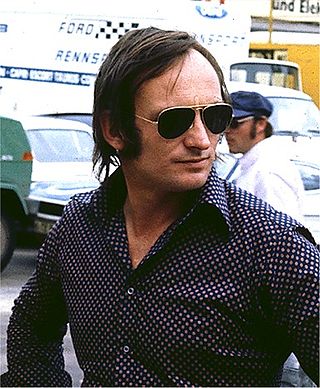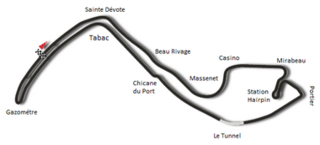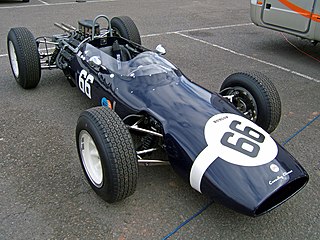
The Cooper Car Company is a British car manufacturer founded in December 1947 by Charles Cooper and his son John Cooper. Together with John's boyhood friend, Eric Brandon, they began by building racing cars in Charles's small garage in Surbiton, Surrey, England, in 1946. Through the 1950s and early 1960s they reached motor racing's highest levels as their mid-engined, single-seat cars competed in both Formula One and the Indianapolis 500, and their Mini Cooper dominated rally racing. The Cooper name lives on in the Cooper versions of the Mini production cars that are built in England, but is now owned and marketed by BMW.

Christopher Arthur Amon was a New Zealand motor racing driver. He was active in Formula One racing in the 1960s and 1970s, and is widely regarded as one of the best F1 drivers never to win a championship Grand Prix. His reputation for bad luck was such that fellow driver Mario Andretti once joked that "if he became an undertaker, people would stop dying". Former Ferrari Technical Director Mauro Forghieri stated that Amon was "by far the best test driver I have ever worked with. He had all the qualities to be a World Champion but bad luck just wouldn't let him be".

The 1966 Monaco Grand Prix was a Formula One motor race held at the Circuit de Monaco on 22 May 1966. It was race 1 of 9 in both the 1966 World Championship of Drivers and the 1966 International Cup for Formula One Manufacturers. The race was the first World Championship event of a new era for Formula One, for which engine regulations were altered from 1.5 litres of maximum engine displacement to 3.0 litres. The race was the 24th Monaco Grand Prix.

The 1968 Formula One season was the 22nd season of the FIA's Formula One motor racing. It featured the 19th FIA World Championship, which commenced on 1 January, and ended on 3 November after twelve races, and numerous non-championship races. Graham Hill won the second of his World Championship titles, with Lotus.

Formula 5000 was an open wheel, single seater auto-racing formula that ran in different series in various regions around the world from 1968 to 1982. It was originally intended as a low-cost series aimed at open-wheel racing cars that no longer fit into any particular formula. The '5000' denomination comes from the maximum 5.0 litre engine capacity allowed in the cars, although many cars ran with smaller engines. Manufacturers included McLaren, Eagle, March, Lola, Lotus, Elfin, Matich and Chevron.
Team Lotus was the motorsport sister company of English sports car manufacturer Lotus Cars. The team ran cars in many motorsport categories including Formula One, Formula Two, Formula Ford, Formula Junior, IndyCar, and sports car racing. More than ten years after its last race, Team Lotus remained one of the most successful racing teams of all time, winning seven Formula One Constructors' titles, six Drivers' Championships, and the Indianapolis 500 in the United States between 1962 and 1978. Under the direction of founder and chief designer Colin Chapman, Lotus was responsible for many innovative and experimental developments in critical motorsport, in both technical and commercial arenas.

The Lotus 49 was a Formula One racing car designed by Colin Chapman and Maurice Philippe for the 1967 F1 season. It was designed around the Cosworth DFV engine that would power most of the Formula One grid through the 1970s. It was one of the first F1 cars to use a stressed member engine combined with a monocoque to reduce weight, with other teams adopting the concept after its success. It also pioneered the use of aerofoils to generate downforce.

The Tasman Series was a motor racing competition held annually from 1964 to 1975 over a series of races in New Zealand and Australia. It was named after the Tasman Sea which lies between the two countries. The Tasman Series races were held in January through to late February or early March of each year, during the Formula One off season, taking advantage of winter in the Northern Hemisphere to attract many top drivers to summer in the south. The Tasman Cup was the permanent trophy awarded to the winning driver.

The McLaren M2B was the McLaren team's first Formula One racing car, used during the 1966 season. It was conceived in 1965 and preceded by the M2A development car. Designed by Robin Herd, the innovative but problematic Mallite material was used in its construction. The car was powered by Ford and Serenissima engines but both lacked power and suffered from reliability issues.

The Cooper T81 is a Formula One car produced by the Cooper Car Company for the 1966 Formula One season. It represented something of a comeback for Cooper's fortunes, winning two races and enabling Cooper to finish third in the Constructors' Championship in 1966 and 1967.
Four-wheel drive (4WD) has only been tried a handful of times in Formula One. In the World Championship era since 1950, only eight such cars are known to have been built.

The Cooper T51 was a Formula One and Formula Two racing car designed by Owen Maddock and built by the Cooper Car Company for the 1959 Formula One season. The T51 earned a significant place in motor racing history when Jack Brabham drove the car to become the first driver to win the World Championship of Drivers with an engine mounted behind them, in 1959. The T51 was raced in several configurations by various entrants until 1963 and in all no less than 38 drivers were entered to drive T51s in Grand Prix races.

The BRM P261, also known as the BRM P61 Mark II, is a Formula One motor racing car, designed and built by the British Racing Motors team in Bourne, Lincolnshire, England. The BRM P261 was introduced for the 1964 Formula One season, and its design was an evolution of Tony Rudd's one-off BRM P61 car of 1963. The P261 had a relatively long racing career; variants of the car were still being entered for Formula One World Championship Grands Prix as late as 1968. During the course of their front-line career BRM P261s won six World Championship races, in the hands of works drivers Graham Hill and Jackie Stewart, and finished second in both the Drivers' and Constructors' Championship standings in 1964 and 1965. Stewart, Hill and Richard Attwood also used works P261s to compete in the Tasman Series in 1966. The BRMs dominated, with Stewart winning four, Hill two, and Attwood one of the 1966 Tasman Series' eight races. Stewart also won the title. The works-backed Reg Parnell Racing team returned in 1967 with Stewart and Attwood, where Stewart added another two wins to his tally. In terms of races won and total Championship points scored, the P261 was the most successful car in BRM's history.

The Brabham BT3 is a Formula One racing car. It was the first Formula One design to be produced by Motor Racing Developments for the Brabham Racing Organisation, and debuted at the 1962 German Grand Prix. The Brabham BT3 was the vehicle with which team owner – then two-time World Champion – Jack Brabham, became the first driver ever to score World Championship points in a car bearing his own name, at the 1962 United States Grand Prix. The following year Brabham also became the first driver ever to win a Formula One race at the wheel of an eponymous car, again driving the BT3, at the 1963 Solitude Grand Prix. The BT3 design was modified only slightly to form the Tasman Series-specification Brabham BT4 cars.

The Brabham BT23 was a formula racing car built by Brabham in 1967.

The Cooper T53 is a Formula One car built by British motorsport team Cooper for the 1960 Formula One season. Jack Brabham drove it to his second World Championship that year, and with teammate Bruce McLaren gave Cooper its second Constructors' Championship.

The Cooper T86 was a Formula One racing car built by Cooper and first raced in 1967. B and C specification cars were also built to accommodate different engines, but the car could not revive Cooper's fortunes and this type represents the last Formula One chassis built and raced by the former champion team.

The Cooper T66 is a Formula One racing car from the Cooper Car Company, which was in use from 1963 to 1964.

The Cooper T77 is a 1.5-litre Formula One car entered in the 1965 Formula One World Championship by the Cooper Car Company.

The Cooper T60 is a Formula One racing car from the Cooper Car Company, which was in use from 1962 to 1965. It won a single World Championship Grand Prix, the 1962 Monaco Grand Prix, driven by Bruce McLaren.


















